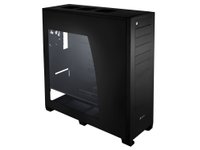Corsair Enters the Case Market
Shortly after the new year rang in there were reports made by various sources that Corsair was planning to enter the PC case market and it came through, showing off a case at CeBIT.
The case still lacks a name at this point in time, but it looks to be quite a beast.
The power supply unit (PSU) mounts at the bottom of the case at the rear, inside a separate compartment which is divided away from the motherboard zone and contains two hard drive mounting points. The bottom compartment also has a 120mm fan above it which pulls heat out of the central zone of the case.
A few interesting aspects of this case is the inclusion of the triple 120mm fan ports along the top panel of the case. These fan ports are spaced for a triple 120mm fan radiator and the top panel is even pre-drilled and ready to mount a radiator as well. Water cooling cut-outs have also been made in the rear of the case making this case a prime candidate for water cooling enthusiasts. It also appears from the images that there is a large gap between the motherboard mount and the right outside panel, which provides an excellent location for hiding cables and other modifications you want ‘out of sight’.
The inclusion of four SATA hot-swap trays and SATA backplane is another attractive feature included with this case. While the user can mount two static drives in the bottom compartment, four more drives could be used for a RAID configuration to store data. Alternatively the two bottom drive mounts could be used for mirrored data storage on two 2 GB SATA drives, for example, while the removable trays could be used for data and multiple operating system capability.
The rest of the features included are what most people would typically expect, such as tool-less access, adequate air flow features, spacious design and lightweight. As we have mentioned, there is no name for this unit currently, and there is no expected price mentioned either.
No details on availability or pricing as of yet.
Get Tom's Hardware's best news and in-depth reviews, straight to your inbox.



-
StupidRabbit ReplyAlternatively the two bottom drive mounts could be used for mirrored data storage on two 2 GB SATA drives, for example, while the removable trays could be used for data and multiple operating system capability.
2GB? i guess customers would have to choose whether they want to backup half of their Dark Knight DVD or business documents :D -
A Stoner Looks good.Reply
Did I miss the part where it said what material it is made from? I hope it is high quality aluminum. Steel = too heavy while alot of plastic = too flimsy and not alot of EM protection from other components/computers stacked next to it. -
mickey21 They mentioned it would be lightweight so that only points to aluminum or aluminum composite of some sort. I like the case design and it seems to have a bit of thought to it. Hope they dont kill it off in the pricing area, but we'll see.Reply -
The_Blood_Raven Looks and sounds great, can't wait for the reviews to come in, I love me some aluminum high class cases.Reply -
RiotSniperX Is it a mid or full tower?Reply
I cant tell from the picture because its against a black wall.
If it was full tower i might look into it, might replace the Antec 1200 im getting, but we'll see. -
falchard Looks poorly ventilated, hopefully they make some better cases. Although I like the pre-drilled areas for cable routing.Reply -
jerreece Wow, looks like there are three (3) vented opens on the TOP of the case. I wonder if you'll be able to attach three 90mm case fans then?Reply
That separator between the PSU and the rest of the case may keep it from heating up your GPU, etc. However, how much is it going to restrict cool air from getting TO your PSU?
Hard to see, but it looks like there's a 90/120mm fan installed on that separator, right near the front drive bays. Wonder if that's supposed to blow air down into your PSU? Or up away from the PSU?
